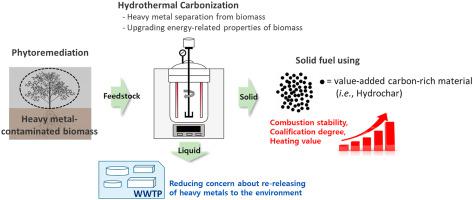Environmental Pollution ( IF 8.9 ) Pub Date : 2020-11-26 , DOI: 10.1016/j.envpol.2020.116127 Jongkeun Lee , Ki Young Park

|
In this study, heavy metal-containing sunflower residues obtained from a phytoremediation site were hydrothermally carbonized at 160–260°C. The properties of hydrochar thus produced were evaluated with respect to its potential as solid fuel. The results confirmed that hydrothermal carbonization (HTC) reduced the concentration of heavy metals in hydrochars, with the concentration lower than the maximum permissible level of domestic standards for bio-solid refuse fuel. Higher HTC temperatures resulted in improved energy-related properties of the hydrochar (i.e., coalification degree, fuel ratio, and higher heating value); however, HTC temperatures between 200–220°C were deemed suitable for energy retention efficiency. Furthermore, as hydrochar contains low nitrogen and ash content, it can be considered as a clean energy source. The results of this study suggest a sustainable approach to the disposal and effective utilization of contaminant-containing biowastes. Moreover, this study suggests linking biomass cultivation for phytoremediation and converting the phytoremediated biomass into value-added solid fuel.
中文翻译:

通过水热碳化将含重金属的生物废物从植物修复场所转化为增值固体燃料
在这项研究中,从植物修复位点获得的含有重金属的向日葵残留物在160–260°C进行水热碳化。就其作为固体燃料的潜力,评估了如此生产的烃的性质。结果证实,热液碳化减少了碳氢化合物中重金属的浓度,其浓度低于生物固体垃圾燃料国内标准的最大允许水平。更高的HTC温度导致改善了与水有关的能量相关特性(即,煤化程度,燃料比和更高的发热量);但是,HTC温度在200–220°C之间被认为适合保持能量效率。此外,由于水煤中的氮和灰分含量较低,因此可以将其视为清洁能源。这项研究的结果提出了一种可持续的方法来处理和有效利用含污染物的生物废物。此外,这项研究建议将生物量种植与植物修复联系起来,并将植物修复的生物量转化为增值的固体燃料。



























 京公网安备 11010802027423号
京公网安备 11010802027423号